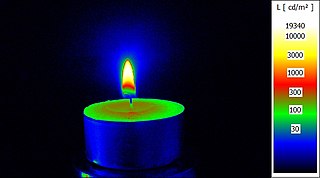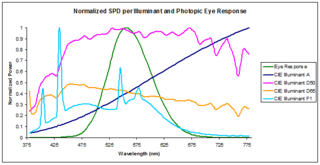
Brightness is an attribute of visual perception in which a source appears to be radiating or reflecting light. [1] In other words, brightness is the perception elicited by the luminance of a visual target. The perception is not linear to luminance, and relies on the context of the viewing environment (for example, see White's illusion).
Contents
Brightness is a subjective sensation of an object being observed and one of the color appearance parameters of many color appearance models, typically denoted as . Brightness refers to how much light appears to shine from something. This is a different perception than lightness, which is how light something appears compared to a similarly lit white object. [2]
The adjective bright derives from an Old English beorht with the same meaning via metathesis giving Middle English briht. The word is from a Common Germanic *berhtaz, ultimately from a PIE root with a closely related meaning, *bhereg- "white, bright". "Brightness" was formerly used as a synonym for the photometric term luminance and (incorrectly) for the radiometric term radiance . As defined by the US Federal Glossary of Telecommunication Terms (FS-1037C), "brightness" should now be used only for non-quantitative references to physiological sensations and perceptions of light. [3] Brightness is an antonym of "dimness" or "dullness".
With regard to stars, brightness is quantified as apparent magnitude and absolute magnitude.
Two pictograms resembling the Sun with rays are used to represent the settings of luminance in display devices. They have been encoded in Unicode since version 6.0 (October 2010) in the Miscellaneous Symbols and Pictographs block under U+1505 as "low brightness symbol" (🔅) and U+1F506 as "high brightness symbol" (🔆). [4]
The United States Federal Trade Commission (FTC) has assigned an unconventional meaning to brightness when applied to lamps. When appearing on light bulb packages, brightness means luminous flux, while in other contexts it means luminance. [5] Luminous flux is the total amount of light coming from a source, such as a lighting device. Luminance, the original meaning of brightness, is the amount of light per solid angle coming from an area, such as the sky. The table below shows the standard ways of indicating the amount of light.
| Quantity | Unit | Dimension [nb 1] | Notes | ||
|---|---|---|---|---|---|
| Name | Symbol [nb 2] | Name | Symbol | ||
| Luminous energy | Qv [nb 3] | lumen second | lm⋅s | T⋅J | The lumen second is sometimes called the talbot. |
| Luminous flux, luminous power | Φ v [nb 3] | lumen (= candela steradian) | lm (= cd⋅sr) | J | Luminous energy per unit time |
| Luminous intensity | Iv | candela (= lumen per steradian) | cd (= lm/sr) | J | Luminous flux per unit solid angle |
| Luminance | Lv | candela per square metre | cd/m2 (= lm/(sr⋅m2)) | L−2⋅J | Luminous flux per unit solid angle per unit projected source area. The candela per square metre is sometimes called the nit . |
| Illuminance | Ev | lux (= lumen per square metre) | lx (= lm/m2) | L−2⋅J | Luminous flux incident on a surface |
| Luminous exitance, luminous emittance | Mv | lumen per square metre | lm/m2 | L−2⋅J | Luminous flux emitted from a surface |
| Luminous exposure | Hv | lux second | lx⋅s | L−2⋅T⋅J | Time-integrated illuminance |
| Luminous energy density | ωv | lumen second per cubic metre | lm⋅s/m3 | L−3⋅T⋅J | |
| Luminous efficacy (of radiation) | K | lumen per watt | lm/W | M−1⋅L−2⋅T3⋅J | Ratio of luminous flux to radiant flux |
| Luminous efficacy (of a source) | η [nb 3] | lumen per watt | lm/W | M−1⋅L−2⋅T3⋅J | Ratio of luminous flux to power consumption |
| Luminous efficiency, luminous coefficient | V | 1 | Luminous efficacy normalized by the maximum possible efficacy | ||
| See also: | |||||
- ↑ The symbols in this column denote dimensions; "L", "T" and "J" are for length, time and luminous intensity respectively, not the symbols for the units litre, tesla and joule.
- ↑ Standards organizations recommend that photometric quantities be denoted with a subscript "v" (for "visual") to avoid confusion with radiometric or photon quantities. For example: USA Standard Letter Symbols for Illuminating Engineering USAS Z7.1-1967, Y10.18-1967
- 1 2 3 Alternative symbols sometimes seen: W for luminous energy, P or F for luminous flux, and ρ for luminous efficacy of a source.







